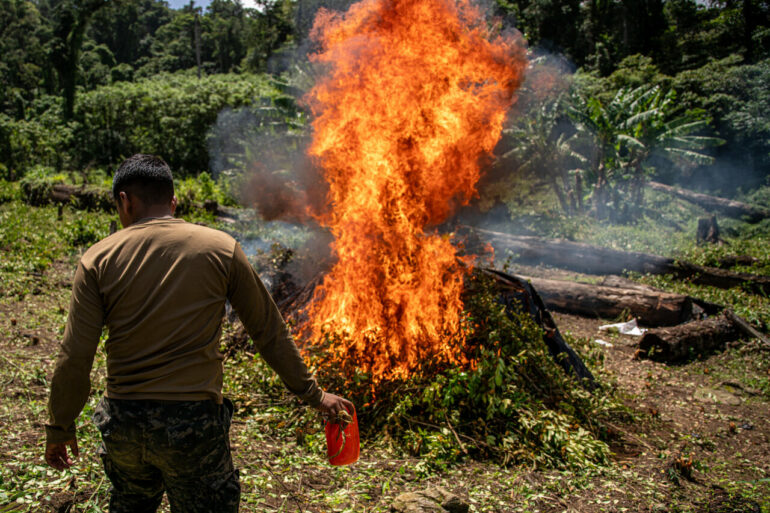For many decades, the coca plant—the main ingredient in cocaine—has been grown almost exclusively in South America. But a new study shows that nearly half of northern Central America appears to be highly suitable for cultivating this lucrative cash crop.
Findings show that 47% of Honduras, Guatemala and Belize have the right climate and soil for commercial coca growing. Most of southern Central America was not suitable.
It’s not a hypothetical concern. Researchers began the study after seeing media reports and press releases about coca eradication operations by police and military forces in several Central American countries.
“South America’s long monopoly on coca production for the international cocaine market is over,” said Kendra McSweeney, corresponding author of the study and professor of geography at The Ohio State University.
“That’s a very significant development in the dynamics of the cocaine trade.”
The study, published Sept. 17 in the journal Environmental Research Letters, was led by Paulo J. Murillo-Sandoval of the Universidad del Tolima in Colombia.
For now, coca growing in Central America appears to be rare and scattered in remote areas, McSweeney said. But this study suggests it has the potential to become more widespread, especially under business-as-usual drug policies.
The researchers drew data from press releases and media reports of 55 separate coca eradication operations in Central America from 2017 through 2022.
McSweeney and her colleagues mapped the approximate locations of each coca field cluster. Next, they used digital data on combined soil, climate and topographic factors that might favor or limit coca farming in those areas. They then used machine-learning models to compare these Central American locations to known coca-growing sites in Colombia.
“This is the kind of assessment that researchers do routinely for standard crops. To see, for example, can soy be grown in this part of Brazil?” McSweeney said.
“But we wanted to know if this illegal crop could be grown in an area where we don’t think it has been grown until recently. And it turns out it is great for growing coca. It’s ideal.”
While nearly half of northern Central America has the right biophysical characteristics to grow coca, a question is why criminal groups are growing coca there at all, given the current coca surplus in South America.
There are no definitive answers, the authors said, but there are some possible theories. Murillo-Sandoval indicated that the end of the armed conflict in Colombia since 2016 leveraged new ideas about how the coca business can be managed. One new way is to explore the potential of growing coca nearer to northern markets, including the United States.
Also, there are a variety of precursor chemicals that are needed to turn coca into cocaine, and those chemicals are less regulated in Central America than they are in Colombia.
Another advantage to Central America is that growing coca there would allow traffickers to avoid Coast Guard interdiction of boats smuggling cocaine north out of South America, shortening the supply chain for traffickers based in Mexico.
“It would be much more convenient and cheaper for them to buy cocaine produced right next door in Guatemala, than have it shipped from Colombia,” McSweeney said. “It is an economic and strategic decision.”
McSweeney said she and her colleagues discussed whether they should publish these results because of ethical concerns.
They were concerned about possibly providing information that could be helpful to organized criminal networks involved in growing coca. They also worried that police and military in Central America could use the information to target law enforcement in the rural communities unlucky enough to be located near coca plantations, and who might erroneously be assumed to be involved, McSweeney said.
But their Central American co-author and collaborators in the region encouraged publication of the research and said that the general public had a right to know and discuss the findings, so they can be prepared.
“The citizens there need to know how big this industry could become. As for the criminals, they’re way ahead of us—they already know about Central America’s agricultural suitability. They’ve been testing growing conditions in multiple countries for years,” McSweeney said.
McSweeney emphasized that coca plantations are still rare in northern Central America, and the researchers are not predicting where coca will be grown in the future. They stress that the coca industry’s future in Central America will depend in part on how the countries involved respond to the current threat.
Murillo-Sandoval said he knows from Colombia’s experience that eradication of coca plantations doesn’t work. It only spreads coca-growing to new areas. McSweeney and colleagues’ previous work has also shown that at-sea interdiction of drug shipments is equally counter-productive. In conclusion to the current study, the researchers urge drug policy analysts and policymakers to consider novel policy and law-enforcement approaches.
Current supply-side approaches to the drug war that rely heavily on law enforcement raids and destruction of growing operations simply encourage criminals to move their operations elsewhere—a dynamic that has played out in South America for decades. McSweeney said, adding that this study shows that Central America is at risk of becoming one of the next places for these destructive dynamics to take root.
“We need to find new ways to battle the drug problem that don’t encourage this outcome,” she said. “The solutions don’t all lie in Central America. We have to re-think our drug policies at home, too.”
More information:
Central America’s agro-ecological suitability for cultivating coca, Erythroxylum spp., Environmental Research Letters (2024). DOI: 10.1088/1748-9326/ad7276. iopscience.iop.org/article/10. … 088/1748-9326/ad7276
Provided by
The Ohio State University
Citation:
Central America could play troubling new role in cocaine trade: Study finds some countries agriculturally ‘ideal’ (2024, September 17)



